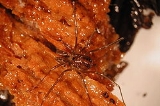
Dyspnoi
Encyclopedia
The Dyspnoi are a suborder of harvestmen, with about 32 genera, and about 320 described species.
Several fossil species are known, including two extinct families.
The superfamilies Ischyropsalidoidea and Troguloidea are monophyletic. However, the families Sabaconidae and Ceratolasmatidae are not; amongst other inconsistencies, Taracus (Sabaconidae) is a sister group to Hesperonemastoma (Ceratolasmatidae).
(Ortholasma bolivari) and northern Thailand
(Dendrolasma angka). Some Troguloidea were also found in tropical regions during the Cretaceous
.
Several fossil species are known, including two extinct families.
The superfamilies Ischyropsalidoidea and Troguloidea are monophyletic. However, the families Sabaconidae and Ceratolasmatidae are not; amongst other inconsistencies, Taracus (Sabaconidae) is a sister group to Hesperonemastoma (Ceratolasmatidae).
Distribution
The Dyspnoi are one of the most conserved biogeographically conserved higher groups of harvestmen. None occur in the Southern Hemisphere, and most families are restricted along temperate regions. The only exceptions are some Ortholasmatinae (Nemastomatidae) inhabiting the tropics on high mountains in MexicoMexico
The United Mexican States , commonly known as Mexico , is a federal constitutional republic in North America. It is bordered on the north by the United States; on the south and west by the Pacific Ocean; on the southeast by Guatemala, Belize, and the Caribbean Sea; and on the east by the Gulf of...
(Ortholasma bolivari) and northern Thailand
Thailand
Thailand , officially the Kingdom of Thailand , formerly known as Siam , is a country located at the centre of the Indochina peninsula and Southeast Asia. It is bordered to the north by Burma and Laos, to the east by Laos and Cambodia, to the south by the Gulf of Thailand and Malaysia, and to the...
(Dendrolasma angka). Some Troguloidea were also found in tropical regions during the Cretaceous
Cretaceous
The Cretaceous , derived from the Latin "creta" , usually abbreviated K for its German translation Kreide , is a geologic period and system from circa to million years ago. In the geologic timescale, the Cretaceous follows the Jurassic period and is followed by the Paleogene period of the...
.
Systematics
Genus and species numbers are from the year 2005.- Ischyropsalidoidea
- CeratolasmatidaeCeratolasmatidaeThe Ceratolasmatidae are a family of harvestmen with eleven described species.The monophyly of this family is questionable; it is composed of three possibly monophyletic groups:...
(4 genera, 11 species) - IschyropsalididaeIschyropsalididaeThe Ischyropsalididae are a family of harvestmen with about 40 described species.-Description:Species in this family range in body length from about four to 8.5 mm. They have moderately long legs. The greatly enlarged chelicerae can be almost twice as long as the body. While they share this feature...
(1 genus, 35 species) - SabaconidaeSabaconidaeThe Sabaconidae are a family of harvestmen with about 50 known species.The species range in body length from 1.2 to 5.5 mm. The relatively small chelicerae are sexually dimorphic. In Taracus the chelicerae are strongly elongated...
(2 genera, 45 species)
- Troguloidea
- DicranolasmatidaeDicranolasmatidaeThe Dicranolasmatidae are a family of harvestmen with about 20 described species in a single genus.-Description:Species of Dicranolasma range in body length from three to 6.4 mm. Most parts of the body are encrusted with soil particles. The anterior region features a large headlike "hood" with the...
(1 genus, 17 species) - † EotrogulidaeEotrogulidaeEotrogulus is an extinct genus of harvestmen known from the Carboniferous fossil record. The genus is the only member of the family Eotrogulidae and contains one species Eotrogulus fayoli. Eotrogulus was found in the Coal Measures of Commentry in northern France, together with Nemastomoides elaveris...
(1 fossil species: Eotrogulus fayoli Thevenin, 1901 from the CarboniferousCarboniferousThe Carboniferous is a geologic period and system that extends from the end of the Devonian Period, about 359.2 ± 2.5 Mya , to the beginning of the Permian Period, about 299.0 ± 0.8 Mya . The name is derived from the Latin word for coal, carbo. Carboniferous means "coal-bearing"...
) - NemastomatidaeNemastomatidaeThe Nemastomatidae are a family of harvestmen with about 170 described species in 16 recent genera. Several fossil species and genera are known.Unlike some related currently recognized families, the Nemastomatidae are monophyletic.-Description:...
(16 genera, 162 species) - † NemastomoididaeNemastomoididaeNemastomoides is an extinct genus of harvestmen known from the Carboniferous fossil record. The genus is the only member of the family Nemastomoididae and contains three described species...
(fossil: 1 genus, 3 species) - NipponopsalididaeNipponopsalididaeThe Nipponopsalididae are a family of harvestmen with two described species.-Description:They range in body length from 2.3 to 4.1 mm. Their eyes are rather large for harvestmen, and they have chelicerae that are longer than their body, and even longer, slender pedipalps and long legs...
(1 genus, 2 species) - TrogulidaeTrogulidaeThe Trogulidae are a family of harvestmen with about 45 known species.Members of this species have short legs and live in soil. They have dirt attached to their bodies, to escape predators. Their body length ranges from 2 to 22 mm. The body is in most genera somewhat flattened and leathery...
(7 genera, 44 species)

